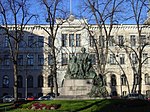Bulevardi
Boulevards in FinlandFinland transport stubsKamppiStreets in Helsinki

Bulevardi (Swedish: Bulevarden, Boulevard) is a boulevard in Helsinki, Finland. It starts at Erottaja and ends at Hietalahdentori. The majority of the boulevard is located in the western part of the Kamppi neighborhood and a small part of Punavuori. Restaurants, cafes, and art galleries line the street. The Alexander Theatre and Sinebrychoff Museum of Art are located on Bulevardi.
Excerpt from the Wikipedia article Bulevardi (License: CC BY-SA 3.0, Authors, Images).Bulevardi
Bulevardi, Helsinki Kamppi (Southern major district)
Geographical coordinates (GPS) Address Website Nearby Places Show on map
Geographical coordinates (GPS)
| Latitude | Longitude |
|---|---|
| N 60.1647 ° | E 24.9382 ° |
Address
Helsingin eurooppalainen koulu
Bulevardi
00120 Helsinki, Kamppi (Southern major district)
Finland
Open on Google Maps











